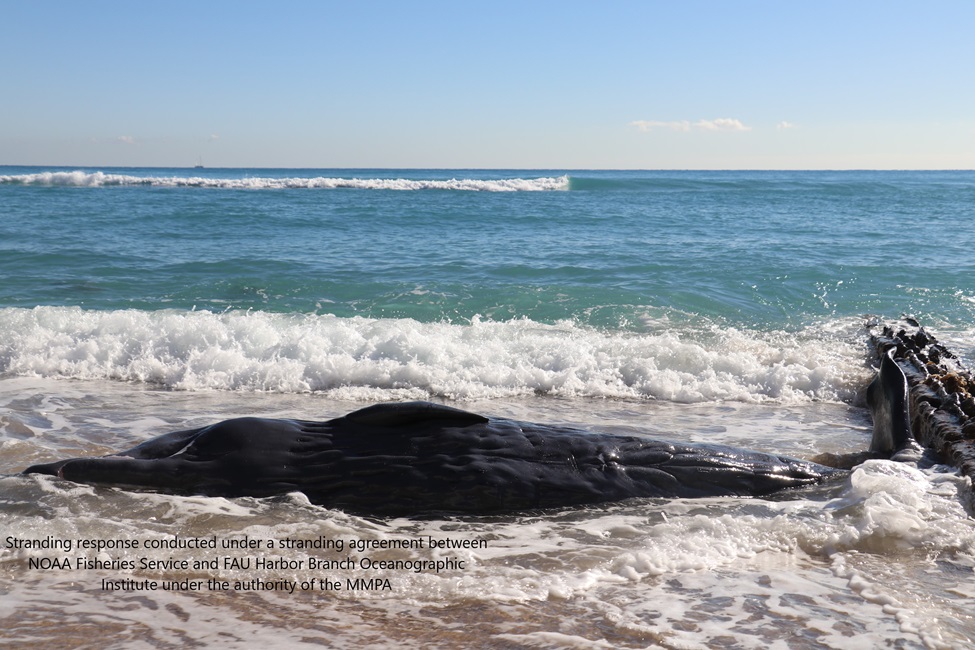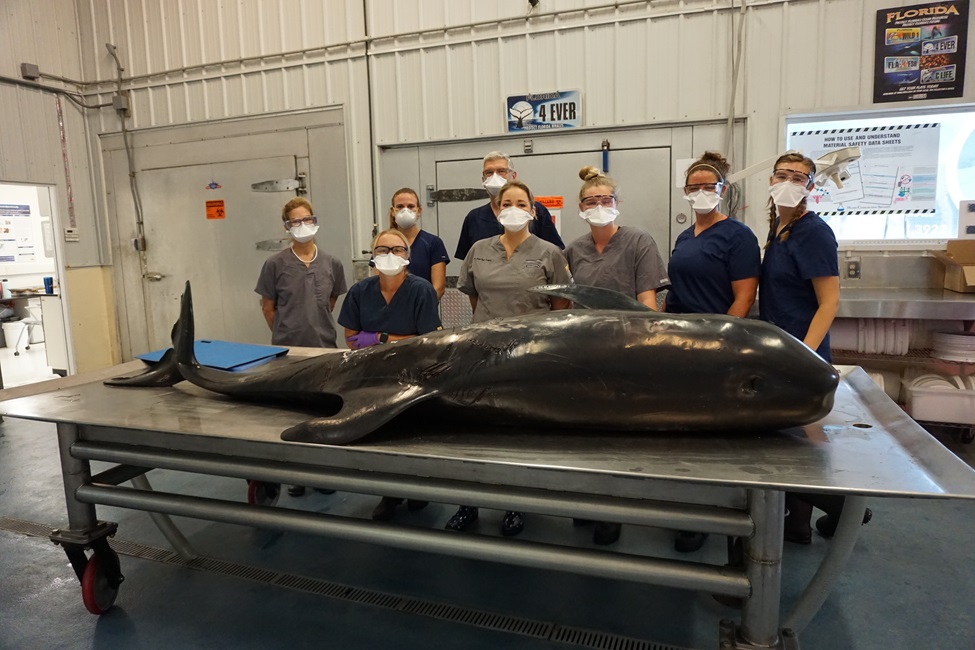Study Details Toxic Elements Found in Stranded Whales and Dolphins

A stranded whale. (Stranding response conducted under a stranding agreement between NOAA Fisheries Service and FAU Harbor Branch Oceanographic Institute under the authority of the MMPA).
Whales and dolphins get their nutrients and essential elements through their diet. While eating fish, squid, octopus, crustaceans and other marine mammals, they are also exposed to heavy metal contaminants.
Elevated levels of toxins have been found in stranded dolphins and whales along the Southeastern Coast of the United States. Monitoring toxic contaminants in these stranded marine animals, which serve as important sentinels of environmental contamination, and whose health may be linked to human health, is vital.
Yet, data remain sparse on how specific elements are distributed within an animal’s body, especially for many rarely encountered species, and how toxicant levels relate to its sex, breed, age and other demographic factors.
A study led by Florida Atlantic University’s Harbor Branch Oceanographic Institute in collaboration with a team of scientists, evaluated the prevalence, concentration and tissue distribution of essential and non-essential trace elements, including heavy metal toxicants in tissue (blubber, kidney, liver, skeletal muscle, skin) and fecal samples collected from 90 whales and dolphins stranded in Georgia and Florida from 2007 to 2021.
Researchers analyzed 319 samples from nine species for concentrations of seven essential (cobalt, copper, iron, manganese, molybdenum, selenium, zinc) and five non-essential (arsenic, cadmium, lead, mercury, thallium) elemental analytes. Species in the study all occupied high and similar trophic levels and consumed a mixture of cephalopods and fishes.
Results of the study, published in the journal Cell Press: Heliyon , showed that Risso’s dolphins (Grampus griseus) and short-finned pilot whales (Globicephala macrorhynchus) had the highest median concentrations of mercury, cadmium and lead, while dwarf sperm whales (Kogia sima) had the lowest.
Adult pygmy and dwarf sperm whales that stranded during 2019 to 2021 had higher concentrations of arsenic, copper, iron, lead, manganese, selenium, thallium and zinc compared to those that stranded during 2010 to 2018, suggesting an increasing risk of exposure over time.
“When we separated phylogenetic groups into age classes and compared median concentrations of heavy metals in specific tissue types between adult specimens of species, we found some interesting trends,” said Annie Page, D.V.M., Ph.D., senior author, an associate research professor and clinical veterinarian, FAU Harbor Branch.
The highest concentrations of many elements (e.g., cadmium, cobalt, copper, manganese, molybdenum, thallium, zinc) were in fecal samples, illustrating the usefulness of this non-invasively collected sample.
Aside from fecal samples, hepatic or liver tissues had the highest concentrations of iron, manganese, mercury, molybdenum and selenium in most species; renal or kidney tissues had the highest concentrations of cadmium; skin had the highest concentrations of zinc; and copper, arsenic and lead concentrations were primarily distributed among the liver and kidneys.
The lowest median concentrations of mercury and cadmium were in liver, kidney, blubber and muscle samples, with the lowest skin mercury concentration and the lowest liver lead concentration all from dwarf sperm whales.
Mercury is one of the most toxic elements in marine systems and can bioaccumulate and biomagnify through marine food webs. Cetaceans are exposed to mercury and other toxic metals mostly by consuming contaminated prey items, which tend to accumulate mercury in liver, muscle and other tissues over time.
“Exposure to heavy metal contaminants can result in oxidative stress, which can impair protein function, damage DNA and disrupt membrane lipids,” said Page. “Heavy metal exposure has been linked to degenerative heart disease, immunodeficiency and increased parasite infestations, among other disease risks.”
Findings from the study provide important baseline data needed to further assess the pathophysiological mechanisms and ecotoxicological hazards associated with exposure to and accumulation of trace elements in tissues of free-ranging whales and dolphins.
“Because tissue concentrations of heavy metal contaminants also vary based on an individual animal’s sex, age class, trophic level and location, among other factors, it is important to first establish baseline values and then continue to monitor cetacean populations for exposure to these toxicants,” said Page.
Species examined in the study were pygmy sperm whales (Kogia breviceps); dwarf sperm whales; Gervais’ beaked whales (Mesoplodon europaeus); Risso’s dolphins; short-finned pilot whales; sperm whales (Physeter macrocephalus); melon-headed whales (Peponocephala electra); a Blainville’s beaked whale (Mesoplodon densirostris); and a false killer whale (Pseudorca crassidens).
Study co-authors represent FAU Harbor Branch; the U.S. Coast Guard Academy; University of Alabama at Birmingham; Hubbs-Sea World Research Institute; Blue World Research Institute; Florida Fish & Wildlife Conservation Commission, Fish & Wildlife Research Institute; and the Georgia Department of Natural Resources.
This work was supported by the Florida State License Plate Program “Protect Wild Dolphins” and “Protect Florida Whales” grants (administered by the Harbor Branch Oceanographic Institute Foundation); the Link Foundation; the John H. Prescott Marine Mammal Rescue Assistance Grant; SeaWorld Busch Gardens Conservation Fund; Discover Florida Ocean’s License Plate; and the Brevard County Tourism and Development Council.

Annie Page, DVM, Ph.D., (pictured in the center), and her team prior to a necropsy of a stranded whale. (Stranding response conducted under a stranding agreement between NOAA Fisheries Service and FAU Harbor Branch Oceanographic Institute under the authority of the MMPA).
-FAU-
Latest News Desk
- Researchers Identify Most Efficient Reinforced Concrete Beam DesignAn FAU engineering professor and international collaborators from Metallurgical Institute in Ukraine and Ariel University in Israel, have identified the most efficient design for reinforced concrete beams.
- FAU Launches Emergency Medical Services FellowshipFAU's Charles E. Schmidt College of Medicine launched it's sixth fellowship to strengthen emergency care through Boca Raton Regional Hospital - part of Baptist Health - and fire-rescue partnerships.
- FAU Receives NIH Grant to Investigate Amphetamine AddictionWith this grant, the FAU research team will use tiny roundworms to study how amphetamines disrupt dopamine, aiming to uncover addiction mechanisms and train the next generation of neuroscience researchers.
- New Study Links NP Autonomy to Provider Shortage ReliefA new study from researchers at FAU highlights how temporary expansions in nurse practitioner (NP) autonomy during the COVID-19 pandemic helped alleviate shortages.
- FAU's Cheryl A. Krause-Parello, Ph.D., Awarded Fulbright U.S. ScholarCheryl A. Krause-Parello, Ph.D., received a Fulbright U.S. Scholar award to study Germany's research and education systems in the academic year 2025-26, focusing on funding and university support for research.
- BEPI Poll: Hispanic Economic Optimism FallsHispanic consumers are spending less as optimism about their economic outlook dwindles amid inflation and economic uncertainty, according to a poll from the Business & Economics Polling Initiative at FAU.






